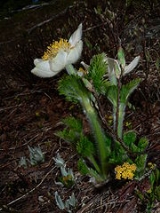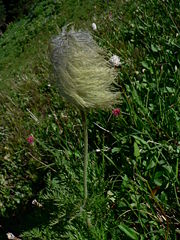
Anemone occidentalis
Encyclopedia
Anemone occidentalis is a herbaceous
plant species in the genus Anemone
and family Ranunculaceae
. Other authorities place it in the genus Pulsatilla. Individuals are 10 to 60 cm tall, from caudices, with 3 to 6 leaves at the base of the plant that are 3-foliolate, each leaflet pinnatifid to dissected in shape. Leaf petiole
s are 6-10 cm long. Leaves have villous hairs and their margins are pinnatifid or dissected. Plants flower briefly mid-spring to mid-summer, usually soon after the ground is exposed by melting snow. The flowers are composed of 5 to 7 sepals (sometimes called tepal
s), normally white or soft purple, also mixed white and blueish purple, one flower per stem. The sepals are 15 to 30 mm long and 10 to 17 mm wide. Flowers have 150-200 stamens. The fruit occurs in heads rounded to subcylindric in shape, with pedicels 15 to 20 cm long. The achene
s are ellipsoid in shape, not winged, covered with villous hairs, with beaks curved that reflex as they age and 20-40 mm long, feather-like. Generally, the fruit persists into fall.

 Native to far western North America including British Columbia to California and Montana, it is found growing in gravelly soils on slopes and in moist meadows.
Native to far western North America including British Columbia to California and Montana, it is found growing in gravelly soils on slopes and in moist meadows.
Herbaceous
A herbaceous plant is a plant that has leaves and stems that die down at the end of the growing season to the soil level. They have no persistent woody stem above ground...
plant species in the genus Anemone
Anemone
Anemone , is a genus of about 120 species of flowering plants in the buttercup family Ranunculaceae in the north and south temperate zones...
and family Ranunculaceae
Ranunculaceae
Ranunculaceae are a family of about 1700 species of flowering plants in about 60 genera, distributed worldwide....
. Other authorities place it in the genus Pulsatilla. Individuals are 10 to 60 cm tall, from caudices, with 3 to 6 leaves at the base of the plant that are 3-foliolate, each leaflet pinnatifid to dissected in shape. Leaf petiole
Petiole (botany)
In botany, the petiole is the stalk attaching the leaf blade to the stem. The petiole usually has the same internal structure as the stem. Outgrowths appearing on each side of the petiole are called stipules. Leaves lacking a petiole are called sessile, or clasping when they partly surround the...
s are 6-10 cm long. Leaves have villous hairs and their margins are pinnatifid or dissected. Plants flower briefly mid-spring to mid-summer, usually soon after the ground is exposed by melting snow. The flowers are composed of 5 to 7 sepals (sometimes called tepal
Tepal
Tepals are elements of the perianth, or outer part of a flower, which include the petals or sepals. The term tepal is more often applied specifically when all segments of the perianth are of similar shape and color, or undifferentiated, which is called perigone...
s), normally white or soft purple, also mixed white and blueish purple, one flower per stem. The sepals are 15 to 30 mm long and 10 to 17 mm wide. Flowers have 150-200 stamens. The fruit occurs in heads rounded to subcylindric in shape, with pedicels 15 to 20 cm long. The achene
Achene
An achene is a type of simple dry fruit produced by many species of flowering plants. Achenes are monocarpellate and indehiscent...
s are ellipsoid in shape, not winged, covered with villous hairs, with beaks curved that reflex as they age and 20-40 mm long, feather-like. Generally, the fruit persists into fall.



